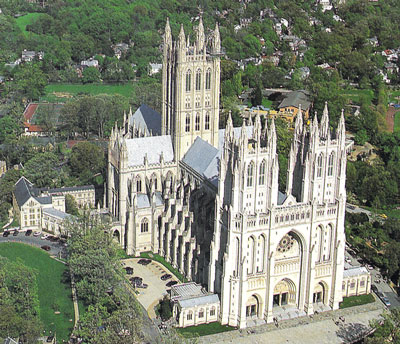Folger Consort at National Cathedral
 Some music sounds at home in a specific acoustic, and of no music is this more true than the glory of the Catholic Church, the learned polyphony of the Renaissance. As Palestrina is the musical counterpart of Michaelangelo, the music of Tomás Luis de Victoria should be prized in the same way as the religious painting of El Greco. As shown at the Folger Consort concert on Friday night in the enveloping acoustic of Washington National Cathedral, Victoria's music was made for a space like this. At the heart of the program was an exquisite performance of Victoria's Officium Defunctorum, a six-voice setting (SSATTB) of the Mass for the Dead. It was composed in 1603, at the death of the Dowager Empress Maria (daughter of Charles V and wife of Maximilian II, Holy Roman Emperor), whom Victoria served as chaplain and choir director in the Discalced Carmelite convent where she had retired from worldly life, Santa Clara in Madrid. A radical Catholic in the Counter-Reformation style, she would be horrified to know that her Requiem Mass was being performed in a heretical church.
Some music sounds at home in a specific acoustic, and of no music is this more true than the glory of the Catholic Church, the learned polyphony of the Renaissance. As Palestrina is the musical counterpart of Michaelangelo, the music of Tomás Luis de Victoria should be prized in the same way as the religious painting of El Greco. As shown at the Folger Consort concert on Friday night in the enveloping acoustic of Washington National Cathedral, Victoria's music was made for a space like this. At the heart of the program was an exquisite performance of Victoria's Officium Defunctorum, a six-voice setting (SSATTB) of the Mass for the Dead. It was composed in 1603, at the death of the Dowager Empress Maria (daughter of Charles V and wife of Maximilian II, Holy Roman Emperor), whom Victoria served as chaplain and choir director in the Discalced Carmelite convent where she had retired from worldly life, Santa Clara in Madrid. A radical Catholic in the Counter-Reformation style, she would be horrified to know that her Requiem Mass was being performed in a heretical church.
Although its texts and the Gregorian incipits that begin many of the movements are standard, this setting of the Requiem was intensely personal to Victoria, marking the end of his happy association with the Dowager Empress. The concluding motet, Versa est in luctum cithara mea (My harp is turned to mourning), was probably intended for the benediction of her body. The text, from Job, is a musician's: even the voice of my music now has to weep now that my beloved patroness is dead. And weep it did in the hands of the vocal ensemble Orpheus, 12 singers of differing pedigrees under the direction of Philip Cave, a founding member of the Tallis Scholars now based here in Washington. The group is still under formation: at last year's concert, they were called Accordia.
The group's sense of ensemble was finely honed, with Cave both singing and directing as he could, which created a few misalignments. The ten higher voices were guided in intonation by the fundamental bass part, its two singers and supporting bass shawm positioned behind them (the buzzing reed instrument dropped out only during the motet Versa est). As pointed out here before, Victoria himself provided continuo and other instrumental parts for his choral music, and the practice of adding instruments to choral textures was well known toward the end of the 16th century. Particularly fine moments came with the reduction of the dynamic to a gentle near-whisper, as in the repeat of the Kyrie eleison movement, at the words "ne cadant in obscurum" in the Domine Jesu Christe, and the repetitions of "quia pius es" at the end of the Communio.
Tallis Scholars, Requiem (settings by Cardoso, Alonso Lobo, Duarte Lobo, and Victoria) (2005)
The Folger Consort's tradition of performing a January concert at National Cathedral has been a grand success (see my reviews of the 2007 and 2006 installments), although only Robert Eisenstein represented the group on the stage. In addition to the Orpheus singers, the Victoria Requiem was also framed by instrumental selections performed by various combinations of wind players from Piffaro. Many of the combinations sounded tuneful and plangent, as well as historically informed, in the cathedral nave, especially the consort of shawms and sackbuts and the surprisingly present quartet of recorders. In truth, both sets of instrumental pieces could have been shortened by half. It would have eliminated some of the weaker pieces, like one that combined a clumsy sackbut with harp, violin, and guitar in the first half, without diminishing the impact of the sound in helping to recreate the musical atmosphere of the 17th century. Two large ensemble motets by Philippe Rogier, a Flemish master of Phillip II's royal chapel, opened and concluded the concert, effectively featuring the entire ensemble of singers and players. It drew attention to the upcoming release of a CD of music by Rogier, recently recorded by the same forces.
As the final chord of the Requiem setting bounced upward toward the cathedral vault, it seemed a terrible waste to have performed this music without offering it on behalf of someone's soul. My own thoughts lingered on the memory of Karlheinz Stockhausen, Luciano Pavarotti, Thomas Stewart, Mstislav Rostropovich, Elisabeth Schwarzkopf, Lorraine Hunt Lieberson. When this piece of music is sung, God is surely listening. May all these musicians rest in peace, and may eternal light shine on them.
The next concerts by the Folger Consort offer a program called Seven Songs of Love for Valentines Day. Soprano Johana Arnold will sing Martin Codax's Seven Songs of Love, Western Europe's first song cycle, and other love songs (February 15 to 18).





















































No comments:
Post a Comment